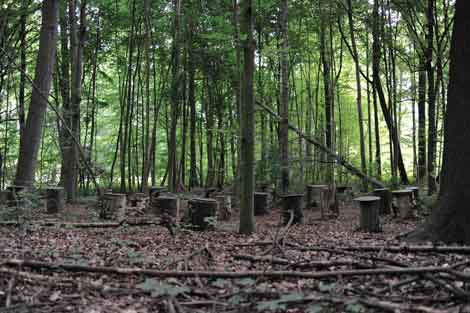More than 30 venues—166 international artists within a few square miles—a forum for ideas rather than conspicuous consumption: it’s Documenta 13! Held every five years in Kassel, Germany, and founded in 1955 by Arnold Bode, an art professor and designer from Kassel, this is the world’s most important and enduring contemporary art show. Depending on the curatorial vision of the exhibition organizer(s) that shape the content, you might encounter a scolding, pedantic treatise on colonialism, or a Teutonic, oppressively intellectual “march-of-death” experience. Thanks to American-born artistic director Carolyn Christov-Bakargiev, this iteration of Documenta was accessible to nearly anyone with interest in the larger world around us, and provided conceptually rich art while also feeding the senses. The overarching theme of the mega-exhibition was “bearing witness,” with all that the phrase implies.
Don’t get me wrong: I love art fairs and revel in such market-driven events. But after the parties and the bright shiny happy pretty things, Documenta was the perfect antidote. Where else in the world could you see, under the same roof, one-quarter of all the ancient carved-stone “Bactrian Princesses” known to exist in the world, then go to debate the relationship between art and philosophy in a closed seminar? The exquisite Earth Goddess-like sculptures from Central Asia date back to the 2nd millennium B.C. and were borrowed from a private collection; the seminar was German philosopher Christoph Menke’s “What is Thinking? Or a Taste That Hates Itself,” held on Tuesdays from 11–1 p.m. in one of the galleries at the Fridericianum museum, the main Documenta venue. This brings a saying to mind: the French eat; the Italians make love; and the Germans think.
Among the most memorable projects was Chicago-based artist Michael Rakowitz’s installation, featuring shards from the destroyed Buddhas of Bamiyan (“All we are breaking are stones”); the burnt remains of books ravaged when the Fridericianum was bombed by the Allies in 1941, and deemed too unimportant to restore; as well as beautiful stone books symbolizing the lost volumes carved by contemporary Afghani carvers using stones quarried at Bamiyan. The emotional impact of this powerful installation was that of a body blow, as our complicity in the destruction of cultural treasures crept into conscience like a bad memory. The title of Rakowitz’s installation (What dust will rise from one horseman?) was taken from an Afghan proverb on cooperation.

Michael Rakowitz, “What Dust Will Rise?,” 2012, Commissioned and produced by Documenta 13 with the support of Dena Foundation for Contemporary Art, Paris, and Lombard Freid Projects, New York, courtesy the artist; Dena Foundation for Contemporary Art, Paris; Lombard Freid Projects, New York, photo by Roman März.
At the Neue Galerie Kassel, Sanja Ivekovic’s “The Disobedient (The Revolutionaries),” 2012, was a stand-out. The Croatian artist assembled plush toy donkeys of all eras, shapes and sizes, and displayed them in a glass case, capturing the attention of hordes of German schoolchildren touring through the galleries. (Note to self: art education is alive and well in Europe!) The piece provided a great example of an artwork that is cute on the surface but has a dark underbelly: adults were absorbed by the text on the opposite wall, describing the political protestors and martyrs symbolized by each cute lil’ stuffed animal, from Anna Mae Aquash to Primo Levi—a broad international assortment of political protestors who died because they were stubborn—like donkeys are reputed to be.
Canadian artists Janet Cardiff and George Bures Miller’s wonderful sound installation “Forest (for a thousand years)” featured a recording of a choral piece sung by the Estonian Philharmonic Chamber Choir, set in a glade deep in the recesses of the landscaped Karlsaue Park. Speakers were hung in the trees surrounding the tree-trunk stool seating arranged in the center of the clearing, and if you found your way there through the mud, your reward was 25 minutes of transcendent, blissful listening to a composition by Estonian composer Arvo Pärt. Cardiff and Miller had another site-specific installation at Documenta, in Kassel’s Hauptbahnhof train station. The “Alter Bahnhof Video Walk” used augmented reality to guide audiences on an engaging walk through the station. After borrowing an iPod from an office inside the station, you were told to take a seat on a bench and wait. As you held the media player in front of you, Cardiff guided you on a walking tour through the station as various video and audio vignettes unfurled. You proceeded as directed, often wheeling around since the recorded events were both mundane and convincingly realistic—people running to catch trains, a dog barking, a baby crying. At one point, Cardiff guided viewers to one of the train platforms, the same platform where Nazis loaded victims onto cars bound for the concentration camps. At another point, Cardiff stopped the narration and “turned off” the video at the request of a mysterious man who preferred to remain incognito.
The tour ended with a duet dance performance, a wonderful chance encounter made all the more powerful by Cardiff and Miller’s playful manipulation of temporality. At Documenta 13 there was nothing to buy—just pure experience to remind you what contemporary art can be.



